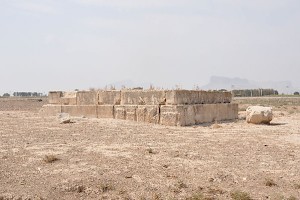Takht-e Rostam
Q71990927Takht-e Rostam or Takht-e Gohar: name of an Achaemenid stone structure near Persepolis, along the road from Naqš-e Rustam to Naqš-e Rajab.

The square platform between Naqš-e Rustam to Naqš-e Rajab poses something of a mystery to researchers. Made of local stone and measuring about 12½ x 12½ meters, it was obviously meant as the base for some kind of higher structure, but we have no idea what that may have been. It has been suggested that it was the tomb of king Cambyses II (530-522), and there is indeed some resemblance to the lower tiers of the tomb of his father Cyrus the Great.
 Takht-e Rostam from the southeast |
 Takht-e Rostam from the southwest |
 Takht-e Rostam from the northwest |
 Takht-e Rostam from the northeast |

However, but this interpretation does not fit well with the fact that he was venerated in Pasargadae (as we known from the Persepolis Fortification Tablets), where his tomb has reportedly been identified.note Of course, a cult on one place does not rule out the possibility of an unfinished tomb somewhere else. Others have argued that it may have been the base of the tomb of Cyrus the Younger, which I find hard to believe; we have only the word of the notoriously inaccurate Ctesias that the rebel was buried at all.

Personally, I was reminded of the platforms on which the Achaemenid kings appear to have worshiped the sacred fire, as we can see on the reliefs of the royal tombs at nearby Naqš-e Rustam and Persepolis. However, this is merely a suggestion.
It appears that the structure was partly destroyed. The stones may have been reused in Persepolis or Istakhr.
As already indicated, the site is along the road from Naqš-e Rustam to Naqš-e Rajab, some five minutes west of the bridge.